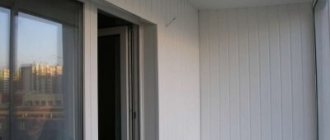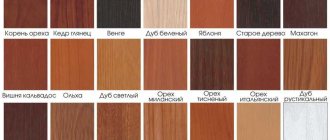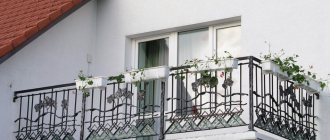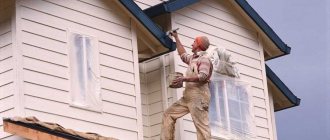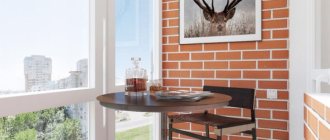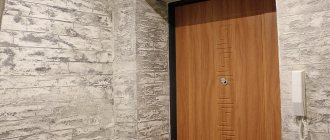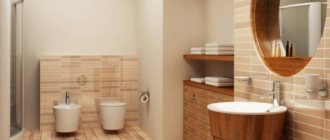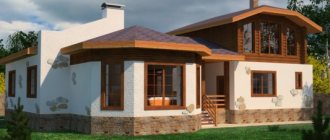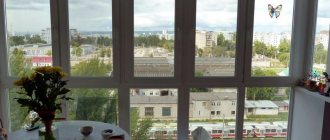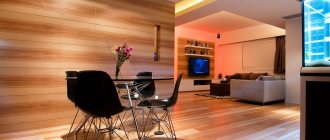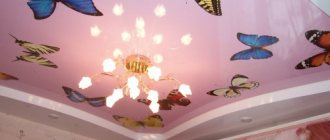Balconies and loggias are no longer an underrated space. With the advent of new technologies, they began to be glazed, insulated and turned into a comfortable room. However, protection from wind or cold alone is not enough for comfort. An aesthetic component is required, which is created using interior design. High-quality interior decoration of the balcony will transform the space. But you need to choose the right materials.
What to consider when choosing finishing materials
Interior decoration of the balcony is the final stage of renovation of the balcony space. First, work on glazing, waterproofing, and insulation is carried out. When they are completed, it is time to finish using decorative elements.
The choice of interior decoration depends on a number of factors:
- Purpose of the premises.
- Functionality of space.
- Design of a nearby room. Because there should be no contrast.
Interior decoration of the loggia
Finishing materials are selected such that they correspond to the conditions of the balcony or loggia. They should be:
- Moisture resistant. Since the humidity on the balcony is higher than in the room.
- Durable. Service life is from two to three decades.
- Resistant to temperature changes with ultraviolet radiation.
- Thermal insulating.
- Protecting against noise.
- Safe for human health.
What panels to cover the inside of the balcony
Nowadays, there is a huge selection of materials on the modern construction market. What types of panels are there for interior work? What panels should I use to cover the inside of the balcony? What are the advantages and disadvantages of these materials? Find out in this article.
Panels for interior decoration of balconies
Depending on the desired result, wood, plastic, laminated and other panels are selected, which will be discussed below. However, when purchasing panels for lining the inside of a balcony, you should take into account several nuances that contribute to the long-term operation of this room.
- If the balcony is located on the sunny side, then you need to take into account the intensity of UV rays and their effect on the interior decoration. When covering the inside of a sunny balcony, choose a material that is resistant to sunlight. And protect this space with curtains or roller blinds.
- If the balcony is dark and cold, choose finishing materials that promote a visual feeling of warmth, such as natural wood.
- You also need to take into account the functionality of the future room and the practicality of the finish.
- If additional heating is not planned on the balcony, you should choose materials that are resistant to temperature changes, humidity and ultraviolet radiation and are practical and have a long service life.
Read: Internal and external decoration of the balcony
Wooden lining
One of the finishing options is wooden lining. This option for covering balconies has not gone out of fashion for many years.
In decor you can always use natural patterns of wood and its natural colors. This is an environmentally friendly material.
By periodically treating with special antiseptics and moisture-isolating preparations, you can extend the life of wooden panels.
It has long been known that wood carries good energy, breathes, emits heat, retains heat, and gives the room a certain coziness and comfort.
The disadvantage of this finish is the high price compared to other materials.
MDF panels
MDF panels were invented by accident, due to a malfunctioning steam press and the forgetfulness of the inventor, William Mason. Chipboards are made from waste obtained after processing wood materials.
MDF panels are stronger and more durable than chipboards, thanks to the use of surface lamination. The panels are resistant to high humidity.
Using a special processing technology, the surface of MDF boards is smoother and has constant dimensions, which is very important when finishing.
MDF boards are produced in three main types, which have water-, fire- and bio-resistant characteristics.
The use of such MDF panels for cladding a balcony or loggia has proven itself and is considered a good option in terms of financial savings.
Installation is carried out using wooden guides, just like when covering with clapboard. This method makes it possible to hide the unevenness of the balcony walls and use thermal insulation materials. If MDF boards are used, special brackets are also required. So the main difference is only in price.
Advantages of MDF boards
1. Moisture resistance (possibility of wet cleaning). 2. Strength (comparable in strength to wood, exceeding chipboard in this characteristic). 3. Low thermal conductivity. 4.
Durability (resistant to temperature changes, not susceptible to mold, fungal diseases, damage by insects) 5. Easy installation without special preparation. 6.
High density of the material (if possible, allows you to process slabs on a milling machine and create a variety of reliefs).
7. Low price characteristic.
Disadvantages of MDF boards
1. Heavy weight (has more weight than a wooden slab of the same size). 2. Increased dust formation (use of a respirator is required when processing slabs). 3.
The need to drill holes for fasteners (nails, screws).
4.
MDF boards contain adhesives and synthetic resins, which increase the moisture resistance of the boards, but often contain harmful ingredients such as formaldehyde.
Plastic panels
Plastic lining and plastic panels have many advantages and are considered one of the economical options for covering balconies and loggias.
They differ only in their connection.
When assembled correctly, the seams between the panels are visually and tactilely almost indistinguishable, and in the final version the assembled canvas is a flat surface.
Material characteristics
1. High strength, thanks to high-quality plastic and special design of stiffeners. 2. High fire resistance. 3. High moisture resistance.
4. High biostability, thanks to the surface coating with special resins, which make the plastic resistant to aggressive substances.
The raw materials for the production of plastic panels are 100% environmentally friendly material. Plastic does not react to ultraviolet radiation, does not change color for a long time, does not require additional processing in the form of painting or varnishing, and is very easy to maintain.
There are a huge number of plastic panels on the market, which vary in color, size, texture, which gives a wide choice for design solutions.
Read: Exterior siding
Laminated panels
Laminated panels are ordinary panels covered with a textured laminate film using special technology.
Advantages of laminated panels
1. Antistatic. 2. Mechanical resistance. 3. Heat resistance. 4. Moisture resistance.
5. High wear resistance.
The panels have a large selection of colors and textures. They successfully imitate the texture of corduroy, wood, leather, and linen, which is widely used by designers when creating eco-style.
The material of laminated panels, unlike plastic ones, is antistatic and does not collect dust, which makes them easier to care for. UV resistance allows them to be used on the sunny side of the apartment. All that remains is to choose what panels to cover the balcony with and get to work.
What materials to use to decorate the inside of the balcony?
Budget options also include finishing the balcony with plasterboard. This type of finishing is especially suitable for people who like to frequently update the interior of a room, so to speak, to suit their mood or... new furniture.
Drywall is used for paint, wallpaper, and can even be decorated with ceramic tiles.
The advantageous characteristics of this material: low price, environmental friendliness, fire resistance, high sound insulation, available for installation.
Drywall
Drywall has excellent qualities:
- Strength.
- Moisture resistance.
- Fire resistance.
- Ease.
- Durability.
- High noise insulation.
- High thermal insulation.
- Environmentally friendly material.
Drywall is a composite material. It comes in sheet form. The base is gypsum. The outer planes are cardboard impregnated with special substances for strength. Drywall is an excellent basis for any finishing option, be it plaster, paint, wallpaper or ceramic tiles.
Variety of materials for wall decoration
The walls of balconies and loggias are decorated with different materials. These surfaces are not subject to stress like floors, so weak and abrasion-resistant options are suitable for them.
Wooden lining
Wooden lining consists of slats with grooves for fastening and a certain profile of the outer side. The balcony, covered with wood, is well sound and heat insulated. Properly treated dry wood lasts a long time. Besides, it looks original. Lining is considered a natural, environmentally friendly product. The main thing when processing is to choose compounds that are safe for humans and intended for internal work.
Balcony finishing with clapboard
The cost of lining depends on the class of material and type of wood:
- Cheap pine and spruce.
- Lining made from soft hardwood is more expensive.
- The most expensive of hardwoods.
Cork finishing
Another natural material is cork. It is made from the bark of the cork tree. During hot pressing, cork particles release lignin, which glues them together. Moreover, a monolithic material is created. Cork is not afraid of moisture, heat, or cold. It does not fade in the sun, perfectly insulates, and blocks out external noise.
Finishing the balcony with cork
Static electricity does not accumulate in such a coating, so the surface collects less dust. Using cork it is easy to create a stylish finish. Disadvantages include relatively high cost and uniform appearance. The material is supplied in rolls or in the form of modular tiles.
MDF panels
MDF is medium density fiberboard. They are available in several versions:
- Flat.
- Embossed.
The surface of the board is covered with veneer or polymer film. The coating imitates the color and pattern of natural wood of different species.
MDF balcony finishing
MDF has many advantages that make it possible to prefer this option. Fiberboards are good in use. Their design is varied. The external finish of the slab imitates wood, but there are also options with plain coatings. Installation of the panels is simple. They can be installed in any direction. MDF is attached to the sheathing, so there is space for placing insulation.
Plastic panels and siding
Finishing balconies with plastic panels is a budget option. They attach simply. The work is carried out in-house. Plastic panels are durable, they do not rot, and do not absorb moisture. The panels vary in appearance. Color ranges from light neutrals to vibrant shades.
Balcony finishing using plastic panels
But bright colored options should not be used for a balcony on the sunny side. But the plastic finish is not without its drawbacks:
- Sensitivity to mechanical damage.
- Negative reaction to sudden temperature changes. Therefore, panels are used for insulated spaces.
- Fast fading when exposed to ultraviolet radiation when installing on the sunny side.
The advantages of this material are price and ease of care. The panels retain heat well and insulate noise.
Finishing the balcony with siding
Vinyl siding is more resistant to temperature changes. This material is also used for internal cladding of the balcony space. Siding has a longer service life than plastic panels. It can be used to inexpensively decorate a balcony. But the resistance to mechanical damage of this material is low. In addition, it has less variety of color shades.
Block house for finishing a balcony
A block house is a group of materials that imitate the appearance of a wooden frame made from logs or timber. For production use:
- Tree.
- Metal.
- Polymers.
Block house with balcony decoration
A vinyl polymer block house weighs ten times less than a wooden one. This modern option will not create additional load on the wall or supporting structure. A natural wooden block house is suitable for lovers of naturalness and authenticity. With its help, a complete feeling of log or timber walls is created. The balcony has a certain flavor. The advantage of this finish is its design, soundproofing and heat-insulating characteristics. If vinyl or metal panels are used, they do not suffer from temperature changes and do not fade in the sun. Using a block house is more expensive than clad with wood clapboard or vinyl siding.
Laminate for wall cladding
Laminate is commonly used as flooring. But they also line balcony walls. The result is a smooth surface in a variety of colors. The material is environmentally friendly, lasts a long time and is easy to install.
Laminate finishing for balconies
When choosing a laminate, take into account certain features:
- Laminate does not like temperature changes.
- Does not tolerate changes in humidity.
Such factors lead to deformation of the boards and peeling of the top layer. Laminate is used on a well-insulated, heated and ventilated balcony.
Plasterboard finishing
Finishing of balcony surfaces with plasterboard is carried out in combination with decorative coatings. Plasterboard sheets are used for leveling and creating a base. Then the base is painted, plastered or covered.
Balcony finished with plasterboard
Moisture-resistant drywall is most often used. It is reliable and durable and will create a smooth base for subsequent decoration.
Balcony finishing with plaster
Drywall is painted with water-based or other paints that allow water vapor to pass through. For plastering, any material options are chosen. From those creating a smooth finish to textured ones.
How to decorate the inside of a balcony with your own hands so that it turns out cheap
How can you qualitatively decorate the inside of a balcony so that it doesn’t hurt your wallet? As a rule, the inside of any balcony space requires appropriate finishing, even one that is located on the sunny, well-lit side. So how to cover a loggia with your own hands using inexpensive materials? This article provides ideas on how you can very cheaply transform your balcony space. To help, you can find useful photos and videos below.
Available finishes
Typically, the repair of a loggia from the inside is completed by internal wall cladding. The choice of materials for this purpose significantly affects the level of waterproofing, as well as the ability to retain heat inside the balcony.
Before moving on to choosing facing materials, you first need to pay attention to all the available finishing options.
Each of them has unique technical characteristics, installation nuances, service life, excellent aesthetic properties and cost.
That is why everyone who wants to turn their balcony into a cozy place first studies the range of offers. The most popular methods for finishing the inside of a balcony are the following materials:
- Lining;
- Plastic;
- drywall;
- Aluminum;
- Wood;
- Plaster;
- Bitumen paints.
Plastic panels: a budget material with many advantages, the disadvantages of which include only the low strength of the coating
The most budget option is plastic panels, which have a very low cost.
Other significant advantages include ease of installation, resistance of the material to moisture and dampness, long service life, as well as a very wide range of color options.
But, despite so many advantages, this type of finishing material has one disadvantage - the low strength of the coating.
What are plastic panels? This is a material that is attached directly to a concrete wall.
The panels are mounted on the surface using special glue and inter-joint fasteners.
In order for them to attach well to all surfaces of the balcony, it is important to have perfectly smooth walls. Otherwise, the panels simply will not stick.
Do-it-yourself interior lining of the balcony
Among the most available materials that are used for cladding the inside of balconies are the following:
- Plastic PVC panels. This is definitely an affordable option that you can implement with your own hands. This is a rather labor-intensive task, but quite understandable for those who have never encountered this. Extreme accuracy, attentiveness and patience are important here. The reward for such complex work will be the money saved that you did not have to pay to professional craftsmen for the work. Before moving on to lining the balcony from the inside with this material, it is important to carry out insulation and sealing work. Drywall: another popular material for finishing a balcony, on top of which you can apply putty or stick wallpaper
- Drywall. It also refers to inexpensive materials that are available to everyone. In addition, among its main advantages is that putty can be applied over the surface, which can then be painted. We also accept the option of wallpaper that can be pasted on top of the drywall.
Advice. The optimal way, which is affordable, is to finish the surfaces with the following widely used materials: cover the floor with linoleum, level the walls and ceiling with putty and cover it with plastic panels.
Cladding balcony walls with plastic
Modern technologies make it possible to use only high-quality and high-tech materials for repair work, which are incredibly versatile, durable and wear-resistant. Their cost also plays a significant role, which should be affordable to everyone.
Today, it is very popular to cover loggias with plastic panels, which are in many ways superior to expensive wooden panels, for example, such as lining.
Any balcony cladding can be additionally decorated with artificial stone: a win-win solution in its aesthetics
Advantages of cladding with this material:
- It retains heat perfectly, preventing cold from getting inside.
- This material is not susceptible to humid environments, temperature changes and all kinds of atmospheric influences.
- Easy to clean every day: just wipe the plastic with a damp cloth to keep it clean.
- By combining this material with plastic windows, you can achieve a unique and effective design solution that is built on harmony.
- Thanks to the extremely rich range of colors, you can create the most sophisticated design solutions. Each buyer has access to white, beige, coffee, yellow, gold, brown, blue, red, green and even black shades.
Ceiling and floor materials
The options considered are used more often for walls, but the balcony being finished requires cladding of other surfaces as well. The ceiling and floor have special characteristics and require a special selection of finishes.
Ceiling lining
Finishing the loggia ceiling with clapboard
It is additionally heat and waterproofed. The cladding is not attached directly to the ceiling surface, but to the lathing. Plastic panels, lining or plasterboard are used as ceiling cladding.
Finishing the balcony ceiling with panels
